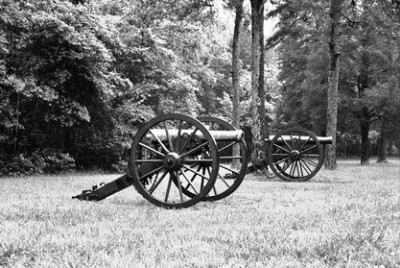
Someone wrote me recently asking if I could do a few posts on some of the mountain towns of the South. Since I’m currently living at the foot of the Great Smoky Mountains and spend most days roaming around the Cumberland Plateau, it shouldn’t be a problem to get to a few of those places soon. I was also asked if I could do a bit more on Civil War sites, and that I can do right away. So, without further ado, we’ll visit the Chickamauga Battlefield, just outside of Chattanooga, across the Georgia line, where one of the bloodiest battles of the Civil War was fought.
 In the summer of 1863, competition between the Union and Confederacy for control of Chattanooga was getting fierce. Union Maj. Gen. William Rosecrans moved his nearly 70,000 men, known as the Army of the Cumberland, from Murfreesboro, TN to square off against Confederate Gen. Braxton Bragg’s Army of Tennessee. Originally positioned to defend the road to Chattanooga, Bragg’s 43,000 men were eventually forced into the city itself by Rosecrans’ forces. In late August, Bragg had to retreat again, this time to LaFayette, GA, 26 miles south of Chattanooga. With the addition of badly-needed reinforcements from Mississippi, East Tennessee, and Virginia, Bragg had 66,000 men when, on September 18, 1863, he tried to get between Union forces and Chattanooga by moving troops along the east bank of West Chickamauga Creek, a gambit which proved unsuccessful. Above is a photo of perhaps the largest of the countless monuments erected on the battlefield, many created by the states from which the soldiers came.
In the summer of 1863, competition between the Union and Confederacy for control of Chattanooga was getting fierce. Union Maj. Gen. William Rosecrans moved his nearly 70,000 men, known as the Army of the Cumberland, from Murfreesboro, TN to square off against Confederate Gen. Braxton Bragg’s Army of Tennessee. Originally positioned to defend the road to Chattanooga, Bragg’s 43,000 men were eventually forced into the city itself by Rosecrans’ forces. In late August, Bragg had to retreat again, this time to LaFayette, GA, 26 miles south of Chattanooga. With the addition of badly-needed reinforcements from Mississippi, East Tennessee, and Virginia, Bragg had 66,000 men when, on September 18, 1863, he tried to get between Union forces and Chattanooga by moving troops along the east bank of West Chickamauga Creek, a gambit which proved unsuccessful. Above is a photo of perhaps the largest of the countless monuments erected on the battlefield, many created by the states from which the soldiers came. A day later, on September 19, 1863, just after dawn, Union infantry engaged Confederate cavalry at nearby Jay’s Mill. Fighting spread amongst what was now well-over 120,000 troops, and the engagement soon covered four miles, the combat often hand-to-hand. At one point, a group of Confederate soldiers became stranded in a ravine near what is known as Viniard Field, and Union Col. John Wilder later wrote, “It seemed a pity to kill men so. They fell in heaps, and I had it in my heart to order the firing to cease, to end the awful sight.”
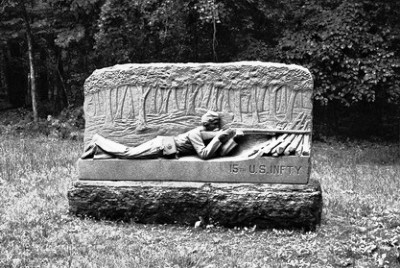
Eventually, Bragg began to drive the Federal army back and, on September 20, Rosecrans received a report that Union Brig. Gen. John Brannan’s division was out of position, putting the Federal line in jeopardy. This information was incorrect, but Union Brig. Gen. Thomas Wood moved his forces to fill the supposed gap in the line, thereby creating a real gap. Coincidentally, Confederate Lt. Gen. James Longstreet’s troops had just started to move toward the area now suddenly left vacant by Wood’s men. Thus, Longstreet’s men broke through the line and began to drive back Federal divisions, including Maj. Gen. Jefferson C. Davis’s.
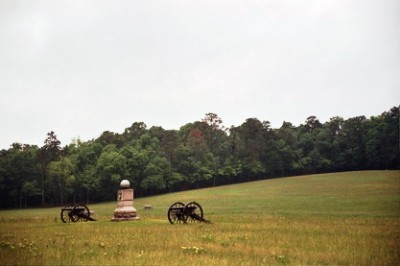
With a hole in their line and Longstreet’s troops moving forward, the Union fell into retreat. Union Gen. George Thomas held the last position at Snodgrass Hill for a time and was thereafter known as the “Rock of Chickamauga.” He also commandeered the Snodgrass family cabin and turned it into a field hospital. But as darkness fell, Thomas and the other Union soldiers withdrew in defeat to Chattanooga. Over the course of two days the Battle of Chickamauga had resulted in 18,000 Confederate soldiers killed, wounded, or missing out of a total of 66,000 troops; Union casualties were 16,000 out of 58,000. The battle would stand as one of the deadliest of the war. Below is a photo of the site on which the Snodgrass cabin stood; the cabin itself is not original.
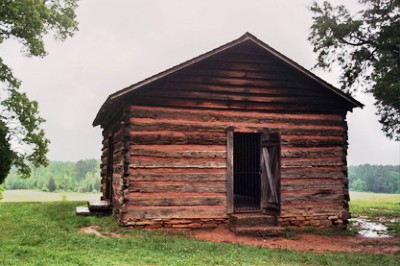
After the battle, Confederates pursued Union forces out of Chickamauga and took Missionary Ridge, Lookout Mountain, and the Chattanooga Valley, effectively barricading Rosecrans’ Army of the Cumberland inside the city. With no way to get supplies in or out, it looked bleak for Federal troops. However, Washington D.C. soon sent 20,000 reinforcements under the command of Maj. Gen. William Sherman and an additional 16,000 men under the command of Maj. Gen. Joseph Hooker to aid the Army of the Cumberland. Thomas then replaced Rosecrans, and Maj. Gen. Ulysses S. Grant took overall command. The first move was to open a supply line from Bridgeport, AL to get food to the stranded troops. Known as the “Cracker Line,” the primary foodstuff delivered to the hungry soldiers was hardtack crackers.
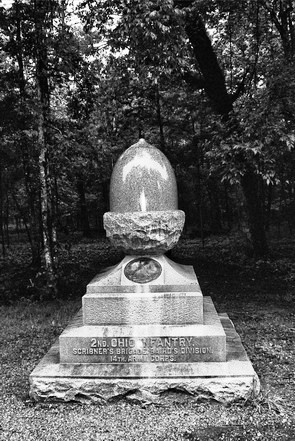 On November 23, 1863, Thomas went on the attack and drove Confederate troops from Orchard Knob. A day later heavy fog conspired to drive the Confederates from the seemingly well-positioned Lookout Mountain. With Bragg’s forces now concentrated on Missionary Ridge, Sherman’s troops moved toward the right flank and Hooker’s toward the left. Hooker was delayed and Sherman’s attack was fought back, so Thomas was ordered to move from his position at Orchard Knob, in the middle of the field, toward the base of Missionary Ridge. Thomas’s men not only marched to the ridge, but, without orders to do so, climbed it and took the position, driving Confederate forces back into Georgia. With the Confederate Army unable to return to the area, Chattanooga would now become the staging ground for Sherman’s march to Atlanta and onward to the sea.
On November 23, 1863, Thomas went on the attack and drove Confederate troops from Orchard Knob. A day later heavy fog conspired to drive the Confederates from the seemingly well-positioned Lookout Mountain. With Bragg’s forces now concentrated on Missionary Ridge, Sherman’s troops moved toward the right flank and Hooker’s toward the left. Hooker was delayed and Sherman’s attack was fought back, so Thomas was ordered to move from his position at Orchard Knob, in the middle of the field, toward the base of Missionary Ridge. Thomas’s men not only marched to the ridge, but, without orders to do so, climbed it and took the position, driving Confederate forces back into Georgia. With the Confederate Army unable to return to the area, Chattanooga would now become the staging ground for Sherman’s march to Atlanta and onward to the sea. 
A couple things: First, the sheer number of men that were at Chickamauga is astounding. There are memorials to divisions from all over the country erected on the battle site. Even though Chattanooga was an important stronghold, it’s hard to understand why all these forces were amassed at Chickamauga Creek, on flat terrain, and at the same time. I guess it must’ve seemed like as good a place to fight it out as any. Also, if you’ve ever seen the lofty bluffs of Lookout Mountain, you’ve gotta wonder how the Confederate soldiers were driven off it. Even with a little fog it seems virtually impossible for the Confederate army to have believed that Union troops were scaling the bluffs. Plus, there was plenty of good mountain behind the Confederates, so the Union couldn’t have starved them off even if they’d wanted to. Add to that the faulty intelligence delivered to Rosecrans and there would seem to have been more than a few key errors on both sides. I suppose everyone could’ve used some walky-talkies. Thanks to the National Park Service for providing info for this post. See ya next time!
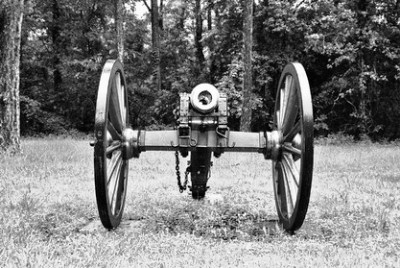
Interesting... All I can say is... The South will rise again! lol
ReplyDelete- Martin